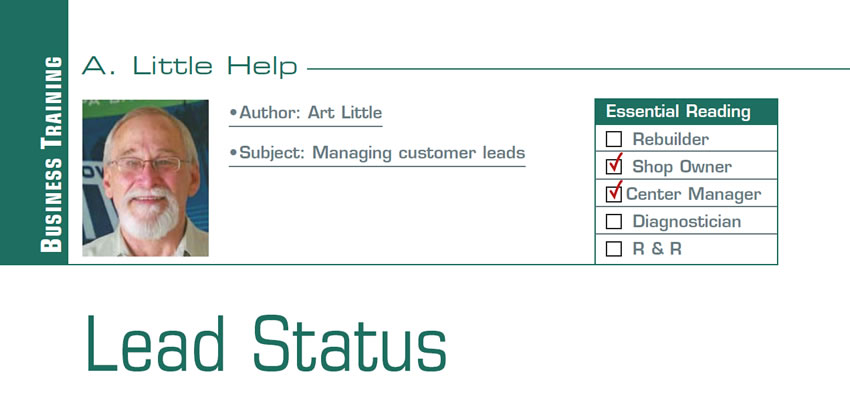
A. Little Help
- Subject: Managing customer leads
- Essential Reading: Shop Owner, Center Manager
- Author: Art Little
A transmission-shop manager will make a minimum of 100 important decisions a week. Let that settle in for a moment. Now, understand that these decisions will determine the shop’s financial success. Every wrong decision he makes has a consequence. Nowadays each mistake can cost upward of $2,000 – makes it hard for a shop owner to sleep at night if you are the worrying type. However, the good news is, there are time-tested policies and procedures that help keep production mistakes to a minimum.
It is logical to say that if a manager is going to be a good manager, he needs to know what’s going on. First, for a manager to make informed decisions, he needs to be informed. If he does not know where he is now, how can he know where he is going ? He must be able to quickly access the information he needs to make an informed decision. The idea here is that the more current and accurate information a manager has at his disposal, the more good decisions he makes. That is the game.

And the game starts with lead control. Leads are expensive, so the manager has to record every lead the shop gets. Then, he needs to know the current status of every lead. He accomplishes this by breaking down each lead into seven categories, so that leads can be quickly identified. Once the leads are in their proper category, that becomes their leads status. The manager can now easily identify whom he needs to call by looking at lead-status categories. This procedure organizes the manager and enables him to be sure that all leads are being worked in a timely manner. This management procedure will maximize the number of repair jobs you get into the shop by organizing the manager and the leads.
As I said before, lead categories become the status of the lead. The manager enters every lead and moves it from category to category as the lead status changes and progresses through the lead cycle. Here are the seven categories in the lead cycle and their definitions:
- Lost lead: These are customers that have not made an appointment.
- Follow-up: These are customers who have made an appointment that is at a future time.
- No-show: These are customers who made an appointment but did not keep it, and they need to be called to be rescheduled.
- No problem: These are customers who showed up for their appointment but after the diagnosis no problem was found.
- Failure to authorize: These are customers who showed up for their appointment but, after the diagnosis, did not authorize any work.
- Working: These are customers who showed up for their appointment and, after the diagnosis, did authorize work. These are work in progress.
- Delivered: These are customers who showed up for their appointment and have picked up their vehicles.
That is about the long and short of it if you want to maximize your chances of getting every lead into the shop. Every lead must be recorded. Move the lead into the proper category as it passes through the process. If that procedure is followed, the manager always knows the status of every lead the shop. The manager now knows where he is and can make an informed decision on where to go.

You can be the greatest advertising genius in the world, but if the manager does not record and keep up with the leads in a timely manner, you are wasting your money.
The manager needs only three basic tools to be successful at retaining leads:
- A telephone procedure that makes the customer want to bring his problem to you.
- A system to record leads. Recording every lead is critical for every shop. We cannot even start to get accurate data together on most other areas of the business if we do not know how many leads we get.
- A system to easily keep up with the current status of every lead. Knowing the current lead status and working the lead in a timely manner is the key to lead retention and conversion.
Getting control of the leads by always knowing the lead status of all your customers is worth the effort. The results yield an informed manager who makes fewer $2,000 mistakes. It also results in a better-informed shop owner. If you track where the leads are coming from and their results, you can start making informed decisions on your advertising choices.
Lead control will put a little more money in your pocket for sure, and that should result in less worry and make it a little easier for you to sleep at night. I wrote an article on telephone procedure that you can read on the transteam website that might help you get started. There are sales techniques in the article as well as policies and procedures used to expedite the lead through the lead cycle.
Having an informed manager is critical to a shop’s financial success.
Knowing the lead status of every customer is only the first part of the game. Only when the manager knows the “lead status” and “work status” of each customer does he become truly informed and in control of the shop. Next month we will break down the work-in-progress categories and look into labor-control policies and procedures. These policies and procedures will give the manager the tools he needs to know the “current work status” of every lead that is in the “working” category so he can maximize use of labor time in the shop.
See you next month. Until then, set the policy in your shop to record every lead, starting today.

Art Little is the founder of TransTeam. His website is the home of the National Employment Headquarters for the transmission industry. He has been an industry pioneer in Internet technology since 1997, and his background in shops goes back almost 30 years. He is respected nationwide as an owner and manager who specializes in multiple-shop management. Today he is a software developer for the transmission industry, offering apps that make everyday tasks in a transmission shop easy by using today’s technology. TransTeam’s mobile technology puts transmission-shop production on a smartphone. Art invites all Transmission Digest shop-owner fans to go to his website and become a TransTeam fan. Visit www.transteam.com.













